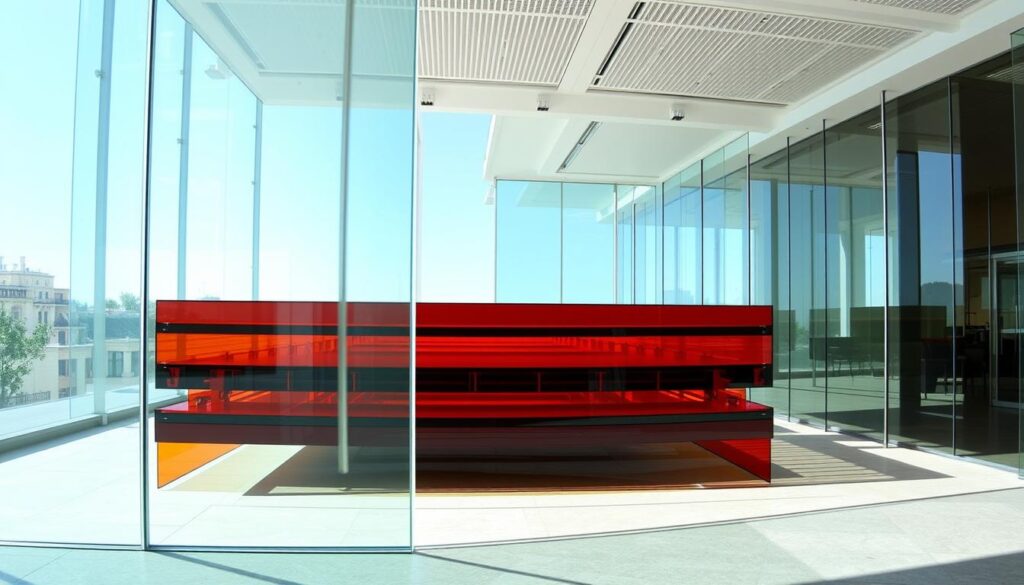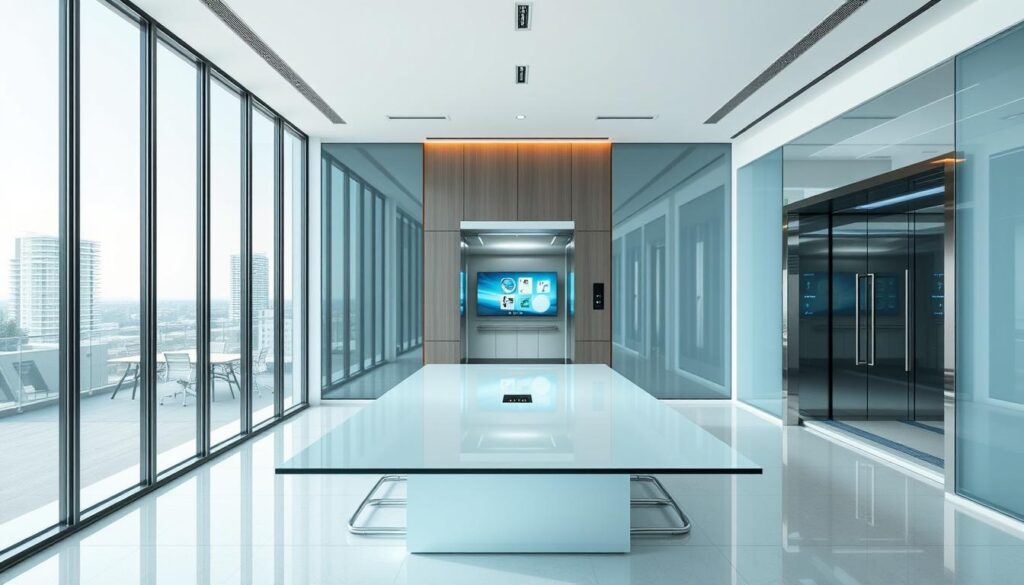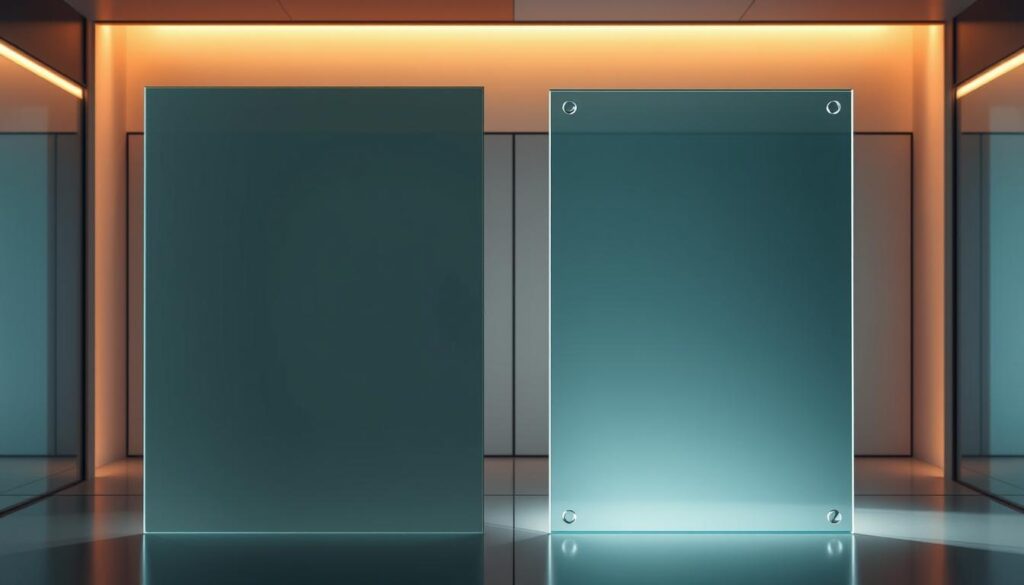Can buildings be designed to adapt to our changing needs, enhancing both energy efficiency and occupant comfort? The answer lies in innovative glass solutions like smart glass technology, which is revolutionizing the way we think about architecture and construction.
Smart glass engineering involves the integration of advanced technologies into glass to provide dynamic control over light transmission and heat transfer. This not only enhances the aesthetic appeal of buildings but also contributes to significant energy savings. For more insights into the types of structural glazing that incorporate such technologies, visit different types of structural glazing.
Key Takeaways
- Innovative glass solutions are transforming the construction industry.
- Smart glass technology offers dynamic control over light and heat.
- Energy efficiency is significantly improved with smart glass engineering.
- Smart glass enhances both the functionality and aesthetic appeal of buildings.
- Advanced glazing technologies are key to sustainable building practices.
Introduction to Smart Glass Engineering
Smart glass, also known as switchable glass, is an innovative technology that allows glass to change its properties in response to various stimuli. This technology has been gaining traction in recent years due to its potential applications in various fields, including architecture, automotive, and aerospace.
What is Smart Glass?
Smart glass is a type of glass that can change its opacity, transparency, or color in response to external stimuli such as light, temperature, or electrical signals. This is achieved through the integration of advanced materials and technologies, including electrochromic, photochromic, and thermochromic materials.
According to a report by Gauzy, smart glass technology has the potential to revolutionize the way we interact with glass in various applications, from energy-efficient windows to advanced display systems.
Brief History of Smart Glass Technology
The concept of smart glass has been around for several decades. The first electrochromic device was developed in the 1960s, marking the beginning of smart glass technology. Since then, significant advancements have been made, including the development of various types of smart glass, such as photochromic and thermochromic glass.
“The development of smart glass technology has been a gradual process, with significant milestones achieved over the years. Today, smart glass is being used in a variety of applications, from architectural glazing to automotive displays.” – Expert in Smart Glass Technology
The evolution of smart glass technology has been driven by advances in materials science and technology. Today, smart glass is being used in a variety of applications, including:
- Energy-efficient windows
- Advanced display systems
- Automotive glazing
- Aerospace applications
| Type of Smart Glass | Description | Applications |
|---|---|---|
| Electrochromic Glass | Changes opacity in response to electrical signals | Energy-efficient windows, automotive glazing |
| Photochromic Glass | Changes opacity in response to light | Eyesight protection, display systems |
| Thermochromic Glass | Changes color in response to temperature | Temperature indication, decorative applications |
Types of Smart Glass

The versatility of smart glass is evident in its various forms, which are revolutionizing the way we interact with glass. Smart glass technology has advanced to cater to different needs, offering innovative glass solutions that are energy-efficient and enhance user experience.
Electrochromic Glass
Electrochromic glass is a type of smart glass that changes its tint in response to an electric current. This technology allows for the control of light transmission, reducing glare and heat gain. Electrochromic glass is often used in energy-efficient buildings to minimize the need for air conditioning and artificial lighting.
Photochromic Glass
Photochromic glass darkens or lightens in response to changes in light intensity. This adaptive technology provides comfort and reduces eye strain. Photochromic glass is commonly used in eyewear and windows.
Thermochromic Glass
Thermochromic glass changes color in response to temperature changes. This type of smart glass is used in various applications, including temperature indicators and decorative features.
Liquid Crystal Glass
Liquid crystal glass switches between transparent and opaque states when an electric current is applied. This technology is used for privacy glazing and display applications.
The following table summarizes the key characteristics of each type of smart glass:
| Type of Smart Glass | Trigger | Application |
|---|---|---|
| Electrochromic | Electric current | Energy-efficient buildings |
| Photochromic | Light intensity | Eyewear, windows |
| Thermochromic | Temperature change | Temperature indicators, decorative features |
| Liquid Crystal | Electric current | Privacy glazing, display applications |
These innovative glass solutions are transforming various industries, from construction to automotive, by providing energy-efficient glass and smart building materials. As technology continues to evolve, we can expect to see even more advanced applications of smart glass.
How Smart Glass Works
Understanding how smart glass works requires delving into its underlying technology and mechanisms. Smart glass technology integrates various scientific principles to create glass that can change its properties in response to different stimuli.
Smart glass operates on several key principles, primarily involving the manipulation of light transmission and reflection. The technology behind smart glass is multifaceted, encompassing electrochromic, photochromic, thermochromic, and liquid crystal technologies.
The Science Behind Smart Glass
The science behind smart glass involves understanding the materials and technologies that enable its dynamic properties. For instance,electrochromic glasschanges its tint in response to an electric current, whilephotochromic glassdarkens or lightens based on the intensity of UV light it’s exposed to.
| Type of Smart Glass | Stimulus | Response |
|---|---|---|
| Electrochromic | Electric current | Changes tint |
| Photochromic | UV light intensity | Darkens or lightens |
| Thermochromic | Temperature change | Changes color or transparency |
| Liquid Crystal | Electric current | Switches from opaque to transparent |
Mechanisms of Light Control
The mechanisms of light control in smart glass are crucial for its functionality. These mechanisms involve the manipulation of light transmission, reflection, and absorption. For example,electrochromic glasscontrols light transmission by altering the state of the electrochromic material in response to an electric current.
The ability of smart glass to control light has significant implications for energy efficiency, privacy, and aesthetics in various applications, from residential and commercial buildings to automotive and aerospace industries.
Applications of Smart Glass

The versatility of smart glass is evident in its wide range of applications across different sectors. Smart glass technology is being increasingly adopted in various industries due to its energy efficiency, privacy benefits, and aesthetic appeal.
Residential Uses
In residential settings, smart glass is used in windows, skylights, and shower enclosures to provide privacy and control light transmission. Homeowners can switch between transparent and opaque states with the touch of a button, enhancing the living experience.
Commercial Uses
Commercial buildings utilize smart glass for energy-saving purposes and to create dynamic, interactive spaces. For instance, smart glass partitions can be used to divide meeting rooms or create private offices.
For more information on commercial applications, visit Smart Glass Country.
Automotive Applications
The automotive industry is integrating smart glass into vehicle windshields and sunroofs to improve driver comfort and safety. Smart glass can adjust tint levels to reduce glare and heat, enhancing the driving experience.
Aerospace and Aviation Applications
In the aerospace sector, smart glass is being explored for use in aircraft windows, providing passengers with control over light and privacy. This technology can also contribute to weight reduction and fuel efficiency.
Here’s a summary of the applications of smart glass in various industries:
| Industry | Applications | Benefits |
|---|---|---|
| Residential | Windows, Skylights, Shower Enclosures | Privacy, Light Control |
| Commercial | Partitions, Windows, Facades | Energy Efficiency, Dynamic Spaces |
| Automotive | Windshields, Sunroofs | Comfort, Safety, Glare Reduction |
| Aerospace | Aircraft Windows | Light Control, Privacy, Weight Reduction |
Advantages of Smart Glass
The advantages of smart glass are multifaceted, ranging from energy efficiency to enhanced privacy. This innovative technology is transforming the way we utilize glass in various applications, from residential and commercial buildings to automotive and aerospace industries.
Energy Efficiency
One of the primary benefits of smart glass is its ability to improve energy efficiency. By controlling the amount of light and heat that enters a building, smart glass can significantly reduce the need for artificial lighting and heating or cooling systems. This not only lowers energy consumption but also decreases the carbon footprint of buildings.
According to a study, buildings that incorporate energy-efficient glass can reduce their energy consumption by up to 20%. This is a significant step towards achieving sustainability in the construction industry.
“The use of smart glass can lead to substantial energy savings, making it an attractive option for building owners and architects looking to reduce their environmental impact.”
Privacy and Security Benefits
Smart glass also offers enhanced privacy and security features. With the ability to switch from transparent to opaque, smart glass provides users with control over their privacy. This feature is particularly useful in office settings or residential areas where privacy is a concern.
- Enhanced privacy control
- Improved security features
- Flexibility in design and functionality
Aesthetic Appeal
In addition to its functional benefits, smart glass also offers aesthetic appeal. Its sleek and modern design can enhance the visual appeal of buildings, making it a popular choice among architects and designers.
| Feature | Benefit |
|---|---|
| Energy Efficiency | Reduces energy consumption |
| Privacy and Security | Enhances user privacy and security |
| Aesthetic Appeal | Modern and sleek design |
UV Protection
Smart glass also provides UV protection, blocking harmful ultraviolet rays that can damage furniture and other interior elements. This feature helps in preserving the interior of buildings and vehicles.
By incorporating smart glass into their designs, architects and builders can create more sustainable, secure, and aesthetically pleasing structures.
Challenges in Smart Glass Engineering

Despite its numerous benefits, smart glass technology faces several challenges that need to be addressed for widespread adoption. The development and implementation of advanced glass engineering are complex processes that involve overcoming various obstacles.
Cost Considerations
One of the primary challenges facing smart glass technology is the high cost associated with its production and installation. The use of advanced materials and manufacturing processes contributes to the elevated costs, making it less competitive with traditional glass solutions.
Efforts to reduce costs are underway, including the development of more efficient manufacturing techniques and the exploration of alternative materials. For instance, advancements in smart glasses technology could potentially translate to cost reductions in smart glass engineering.
Technical Limitations
Smart glass engineering is also hindered by technical limitations, including issues related to durability, reliability, and performance. The integration of complex technologies, such as electrochromic or liquid crystal materials, requires sophisticated control systems and power management.
Addressing these technical challenges involves ongoing research and development, focusing on improving the lifespan and efficiency of smart glass products. Innovations in futuristic glass applications are expected to drive progress in this area.
Environmental Impact
The environmental impact of smart glass technology is another significant challenge. The production process involves the use of various materials, some of which may have adverse environmental effects. Additionally, the energy efficiency benefits of smart glass must be weighed against the overall lifecycle environmental impact.
To mitigate these concerns, manufacturers are exploring sustainable materials and production methods. The adoption of environmentally friendly practices is crucial for the long-term viability of advanced glass engineering.
Future Trends in Smart Glass
Smart glass technology is on the cusp of a significant breakthrough, transforming urban landscapes. As we look to the future, several trends are emerging that promise to take smart glass to the next level.
Innovations in Materials and Design
One of the most exciting developments in smart glass is the innovation in materials and design. Researchers are continually exploring new materials that can enhance the performance, durability, and aesthetic appeal of smart glass. For instance, advancements in electrochromic technology are making it possible to create glass that can change its tint in response to electrical signals, reducing the need for blinds or curtains.
The design of smart glass is also becoming more sophisticated, with companies integrating nanotechnology to improve its optical properties. This not only enhances the functionality of smart glass but also opens up new possibilities for its application in various industries.
Smart Glass in Smart Cities
Smart glass is set to play a crucial role in the development of smart cities. By integrating smart glass into building design, cities can become more energy-efficient, reducing their carbon footprint. Smart glass can help regulate the amount of light and heat that enters buildings, thereby decreasing the need for artificial lighting and air conditioning.
Moreover, smart glass can contribute to the aesthetic appeal of urban environments. With the ability to change its opacity or tint, smart glass can be used to create dynamic public art installations or to enhance the visual appeal of architectural landmarks.
Integration with IoT Technology
The integration of smart glass with IoT technology is another significant trend. By connecting smart glass to the Internet of Things (IoT) network, it becomes possible to control and monitor smart glass remotely, enhancing its functionality. For example, smart glass integrated with IoT can be programmed to adjust its tint based on the time of day or the amount of sunlight it receives.
This integration also enables the collection of data on how smart glass is used, providing valuable insights for architects, builders, and city planners. It can help in optimizing building performance and improving occupant comfort.
As smart glass continues to evolve, we can expect to see even more innovative applications of this technology. With its potential to transform urban landscapes and improve our quality of life, smart glass is indeed a technology worth watching.
Smart Glass vs. Traditional Glass

The comparison between smart glass and traditional glass reveals significant differences in performance and user experience. As buildings become more sophisticated, the choice between these two types of glass is crucial for architects, builders, and homeowners.
Performance Comparison
Smart glass outperforms traditional glass in several key areas. Its ability to change opacity or tint in response to environmental conditions makes it highly adaptable. For instance, electrochromic smart glass can adjust its tint to control the amount of light entering a room, reducing the need for artificial lighting and minimizing heat gain.
Energy Efficiency: Smart glass can significantly reduce energy consumption by optimizing natural light usage and minimizing heat transfer. In contrast, traditional glass often relies on fixed tinting or coatings, which can be less effective in varying conditions.
Cost-Benefit Analysis
While smart glass is generally more expensive than traditional glass upfront, its long-term benefits can outweigh the initial cost. The energy savings and extended lifespan of smart glass can lead to significant cost reductions over time.
- Reduced energy bills due to improved thermal regulation
- Lower maintenance costs as smart glass can be more durable
- Potential increases in property value due to advanced technology features
A detailed cost-benefit analysis is essential to understand the economic implications of choosing smart glass over traditional glass.
User Experiences
User experiences with smart glass have been largely positive, with occupants appreciating the comfort and flexibility it provides. The ability to control light and temperature can enhance productivity and well-being in both residential and commercial settings.
“Smart glass has transformed our office environment. The ability to adjust the tint of our windows has improved employee comfort and reduced our energy costs.”
In conclusion, while traditional glass has its advantages, smart glass offers a range of benefits that make it an attractive choice for modern buildings.
Manufacturing Processes for Smart Glass
Advanced glass engineering is at the heart of smart glass manufacturing, involving cutting-edge production methods. The production of smart glass is a complex process that requires precise control over various parameters to achieve the desired performance characteristics.
The manufacturing process of smart glass involves several key steps, including the preparation of the glass substrate, the application of the smart glass technology, and the integration of control systems. Production techniques play a crucial role in determining the quality and performance of the final product.
Production Techniques
Various production techniques are employed in the manufacturing of smart glass, including:
- Liquid Crystal Display (LCD) technology
- Electrochromic technology
- Thermochromic technology
For a detailed overview of the production process, you can refer to this complete guide to switchable smart glass.
Quality Control Standards
Ensuring the quality of smart glass is critical for its performance and reliability. Quality control standards are implemented throughout the manufacturing process to detect any defects or deviations from the specified requirements.
Some of the key quality control measures include:
- Inspection of the glass substrate for defects
- Testing of the smart glass technology for performance and durability
- Verification of the control systems for proper functioning
By adhering to stringent quality control standards, manufacturers can ensure that their smart glass products meet the required specifications and perform reliably in various applications.
Regulatory Considerations for Smart Glass

The growing adoption of smart glass engineering necessitates a closer look at the regulatory considerations that govern its use. As this technology becomes more prevalent in construction and other industries, understanding the regulatory landscape is crucial for manufacturers, builders, and consumers alike.
Industry Standards
Industry standards play a vital role in ensuring that smart glass products meet certain criteria for safety, performance, and durability. Organizations such as the International Organization for Standardization (ISO) and the American National Standards Institute (ANSI) develop and maintain standards that apply to smart glass. These standards cover aspects such as optical quality, durability, and energy efficiency.
For instance, ISO 12543-4:2011 specifies the test methods for the durability of laminated glass, which is relevant for some types of smart glass. Compliance with these standards is often mandatory for product certification and can be a prerequisite for market access in many regions.
Building Codes and Compliance
Building codes are another critical regulatory aspect that affects the use of smart glass. These codes vary significantly by country and even by region within a country, making compliance a complex task for manufacturers and builders. In the United States, for example, the International Building Code (IBC) and the International Residential Code (IRC) provide guidelines that may apply to smart glass installations.
Key considerations include:
- Structural integrity and safety
- Fire resistance and safety glazing
- Energy efficiency and thermal performance
- Accessibility and visibility requirements
To illustrate the compliance process, consider the following table that outlines some key building code requirements for smart glass in different jurisdictions:
| Jurisdiction | Code Requirement | Smart Glass Compliance |
|---|---|---|
| United States (IBC) | Structural integrity, safety glazing | Must meet ASTM E1300 for load resistance |
| European Union (EN) | Energy efficiency, thermal performance | Must comply with EN 410 for optical properties |
| Canada (NBC) | Fire resistance, safety | Must meet CAN/CGSB-12.20 for fire resistance |
As smart glass technology continues to evolve, regulatory frameworks will need to adapt to address new challenges and opportunities. Staying informed about these developments is essential for stakeholders across the smart glass value chain.
The Role of Smart Glass in Sustainability
With its advanced features, smart glass is playing a pivotal role in the development of sustainable architecture. As buildings account for a significant portion of global energy consumption, the integration of smart glass can significantly reduce this burden.
Energy Conservation Potential
Smart glass technology offers substantial energy conservation potential by optimizing the use of natural light and minimizing the need for artificial lighting. This not only reduces energy consumption but also decreases the strain on power grids during peak hours.
- Reduces energy consumption by up to 20% through optimized lighting control.
- Minimizes the need for heating and cooling by regulating heat gain and loss.
- Enhances occupant comfort by providing optimal lighting conditions.
For more insights on the role of smart glass in energy-efficient building design, explore the perspectives shared on LinkedIn.
Lifecycle Assessment
A lifecycle assessment of smart glass reveals its environmental benefits throughout its lifespan, from production to disposal. While the initial production phase may have a higher environmental impact, the long-term benefits of energy savings and reduced maintenance needs offset these costs.
- Initial production phase has a higher environmental footprint.
- Long-term energy savings contribute to a reduced carbon footprint.
- Durable materials minimize the need for frequent replacements.
By adopting smart glass solutions, architects and builders can create structures that are not only aesthetically pleasing but also environmentally sustainable.
Research and Development in Smart Glass

Research and development play a crucial role in shaping the future of smart glass technology. The continuous advancements in this field are driven by the collaborative efforts of academic institutions and industry leaders.
Key Academic Institutions
Several academic institutions are at the forefront of smart glass research. These institutions are conducting pioneering studies that are pushing the boundaries of what is possible with smart glass. For instance, research conducted at Portland State University has explored innovative applications of smart glass technology.
The role of universities in advancing smart glass technology cannot be overstated. They provide the necessary infrastructure and resources for researchers to experiment with new materials and designs. Some of the key areas of focus include improving the energy efficiency of smart glass, enhancing its durability, and developing new applications.
Notable Industry Collaborations
Industry collaborations are vital for translating research findings into practical applications. By working together, academic researchers and industry professionals can develop smart glass solutions that meet real-world needs. For example, collaborations between glass manufacturers and technology companies have led to the development of more advanced electrochromic glass products.
These collaborations often result in the creation of new products and technologies that benefit various sectors, including construction, automotive, and aerospace. The synergy between research institutions and industry players is driving innovation and expanding the potential applications of smart glass.
The impact of these collaborations can be seen in the development of more sophisticated smart glass products. For instance, advancements in responsive glass technology have enabled the creation of glass products that can dynamically adjust their tint in response to environmental conditions.
| Institution/Company | Research Focus | Notable Achievements |
|---|---|---|
| Portland State University | Smart glass applications | Explored innovative uses of smart glass |
| SageGlass | Electrochromic glass | Developed advanced electrochromic glass products |
| Research Frontiers | Smart window technology | Improved smart window technology for various applications |
The future of smart glass engineering looks promising, with ongoing research and development expected to drive further innovations. As advanced glass engineering continues to evolve, we can anticipate seeing more efficient, durable, and versatile smart glass products.
Case Studies of Smart Glass Implementations
The versatility of smart glass has led to its incorporation in numerous high-profile projects, ranging from architectural marvels to advanced transportation systems. This section highlights some of the most noteworthy implementations, showcasing the challenges overcome and the successes achieved.
Noteworthy Projects in Architecture
Smart glass has been increasingly used in architectural designs to enhance energy efficiency, privacy, and aesthetic appeal. One notable example is the Amazon Spheres in Seattle, Washington. This project features over 40,000 square feet of glass, including smart glass panels that help regulate light transmission and reduce energy consumption.
Another significant project is the One Central Park development in Sydney, Australia. This building incorporates smart glass technology to provide shading and reduce the need for air conditioning, thereby lowering its carbon footprint.
“The use of smart glass in architecture not only enhances the building’s functionality but also contributes to its sustainability.” –
- Energy efficiency through dynamic light control
- Enhanced privacy and security features
- Aesthetic appeal with modern glass technologies
Transportation Innovations
In the transportation sector, smart glass is being used to improve safety, comfort, and efficiency. For instance, BMW has incorporated smart glass technology in some of its concept vehicles to provide passengers with adjustable privacy and UV protection.
Aerospace is another area where smart glass is making an impact. Boeing has explored the use of smart glass for aircraft windows, allowing for adjustable tinting to reduce glare and improve passenger comfort.
- Enhanced passenger comfort through adjustable tinting
- Improved safety with reduced glare
- Increased energy efficiency in vehicle and aircraft designs
These case studies demonstrate the potential of smart glass technology to transform various industries. As the technology continues to evolve, we can expect to see even more innovative applications in the future.
Conclusion: The Future of Smart Glass Engineering
The future of smart glass engineering is promising, with potential growth in various sectors, including residential, commercial, automotive, and aerospace applications. As futuristic glass applications continue to emerge, the demand for responsive glass technology is expected to rise.
Growing Opportunities
Smart glass engineering is poised to revolutionize the way we interact with glass in our daily lives. With its ability to change opacity, reflectivity, or color in response to various stimuli, smart glass offers a wide range of benefits, from energy efficiency to enhanced aesthetic appeal.
Industry Stakeholders’ Role
Industry stakeholders must invest in smart glass technology to harness its full potential. By collaborating with researchers and manufacturers, stakeholders can drive innovation and overcome the technical and cost-related challenges associated with smart glass production. As the industry continues to evolve, we can expect to see more widespread adoption of smart glass in various applications, transforming the way we live and work.
